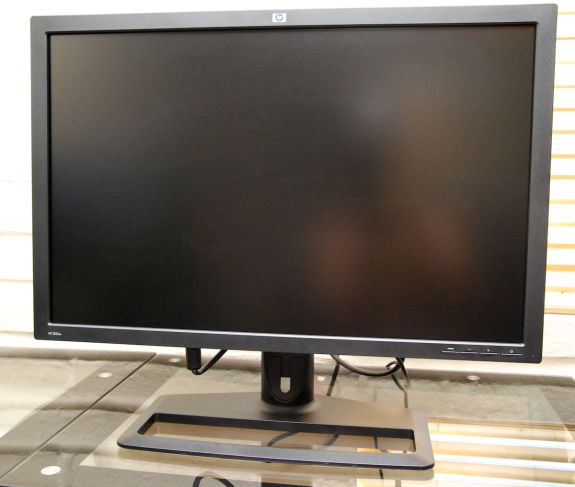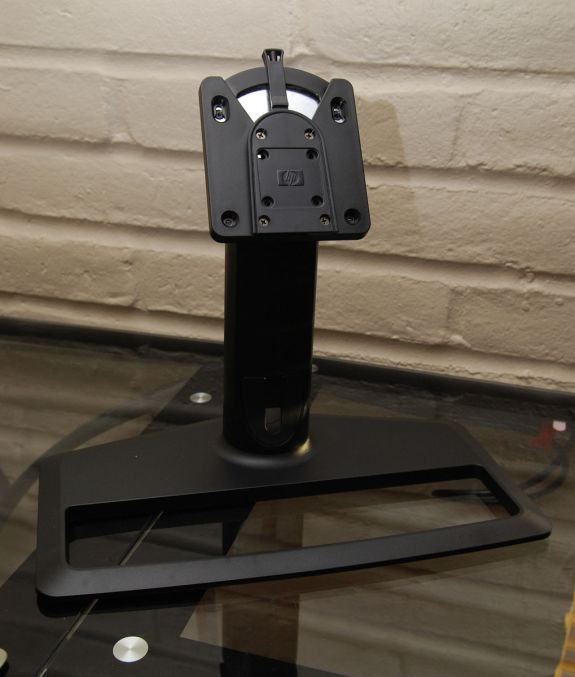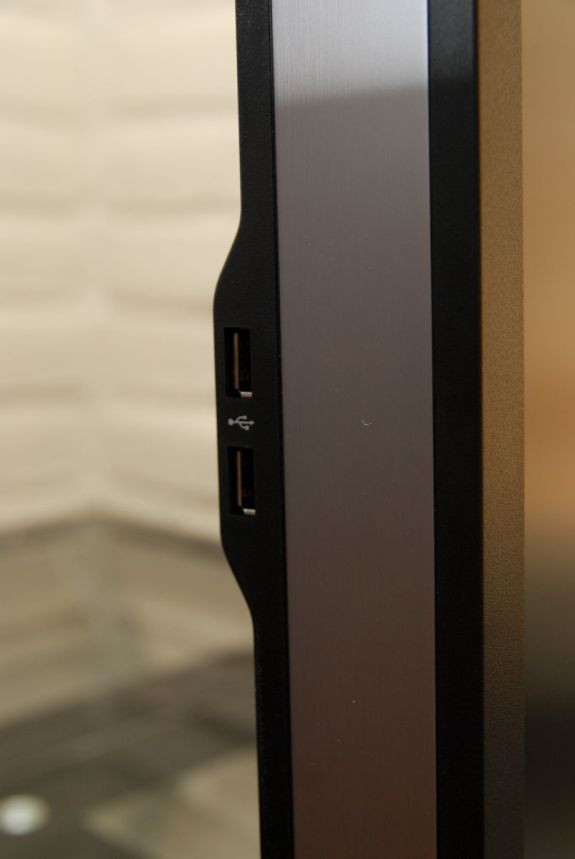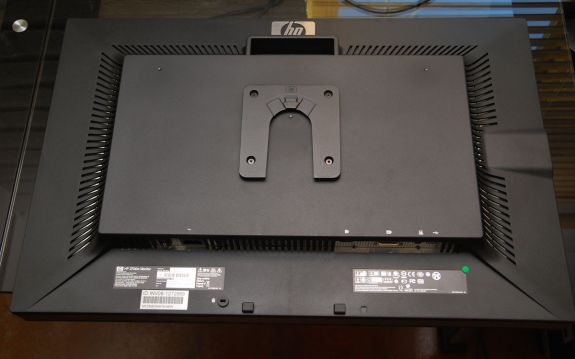A New 30" Contender: HP ZR30w Review
by Brian Klug on June 1, 2010 6:30 PM ESTRight out of the box, HP’s newest 30” display is huge - but you expected that and prepared by already clearing off your desk, right? ;)
Getting the beast of a monitor out of the packaging was actually exceedingly easy; remove one piece of styrofoam, and out comes the stand. One more large piece and the panel is right there for your picking.
The ZR30w display stand packs virtually all the bells and whistles a 30” stand should. There’s 4” of vertical travel, and movement in every axis except pivot (meaning you can’t rotate and use the monitor in portrait mode unless you roll your own VESA stand). HP’s quick release lock system is actually surprisingly useful. The monitor has a slide-in rack which mates up to the display stand; you can slide the monitor in, move a lever into the locked position, and you’re done. This is again the same mechanism used in the LP3065. I was very impressed with how solid and simple this configuration was - there’s no flexing or creaking, and no screws or assembly. It’s always a nice touch when out of box setup is painless - it’s downright critical when you’re juggling a 30” display. In addition, at the base of the monitor is a snap-on cable management cover for routing cables.
Around back is a much larger HP logo, cooling vents, and the display inputs. There’s also a semi hand hold which is great for guiding the monitor into the latch mechanism. Other than that, there’s not much else to speak of except the two USB 2.0 ports on the left of the display. What’s good about the ZR30w’s aesthetics is that they aren’t loud, garish, or overwhelmed with branding.
I noted in previous display reviews that sometimes at the lowest height setting the display connectors can hit the stand or otherwise be obstructed. Note that HP gives almost two entire inches of clearance for cables. This is the way it should be done - no problems connecting DVI cables, especially since dual-link cables are notably beefier.
We always like to use the monitor out of box without calibration for some time and just get a feel for it. While it’s easy to make a case that if you’re shopping for a 30” LCD, you’ve probably got the means to calibrate, it’s a harder case to make on the smaller displays. That said, I was immediately impressed with the ZR30w. Right away, the greens and reds were notably richer than on my two BenQ FP241W displays I use daily.
HP ships its manual on an enclosed CD-ROM, and also part of that installer is a color calibration .icm profile. As a rule, I’m going to start using manufacturer-supplied color profiles for my subjective uncalibrated testing and “uncalibrated” results, since they’re closest to what average users without colorimeters are going to do. Even with this ICM profile however, the panel seemed a bit cool in temperature to me (I later measured and found the same), but everything else seemed quite good.





















95 Comments
View All Comments
Taft12 - Wednesday, June 2, 2010 - link
http://accessories.dell.com/sna/products/Docking_S...$150 CAD - if that's a tough sell, how did you convince them to buy you a monitor that costs over $1000?!
theangryintern - Thursday, June 3, 2010 - link
that's weird. We order docking stations with every single laptop we order. When people are in their office, they all want dual 22" displays.DigitalFreak - Tuesday, June 1, 2010 - link
I'm happy with my Dell U2410 and its HDMI, DVI x 2, Display Port, etc. inputs. :-)ghitz - Wednesday, June 2, 2010 - link
We're talking about 30" here!thorr2 - Tuesday, June 1, 2010 - link
I have the LG W3000H-Bn that I got from newegg. I am very happy with it although it is on the green side before calibration. It would be interesting to see a professional review of it to see how it compares to the others. It is definitely cheaper than a lot of the competition.zsero - Tuesday, June 1, 2010 - link
Sorry, but there is a big misunderstanding in this article:> I have no trouble believing that HP's claims about 1+ billion colors are totally accurate - you have to
> see it in person to believe it. There are just some colors I'm used to not seeing represented very
> well; reds and blues especially, and the photos that I have looked at are spectacular.
Color gamut and the number of colors are totally different things!
But what is _missing_ from the article is that:
1. Using 24 bit color (8-bit per color) with a calibrated display profile you get visible banding.
2. Using 30 bit color (10-bit per color) you can calibrate a monitor without visible banding.
3. For 30 bit color you need DisplayPort and a professional graphics card + driver + OS + software support. For example newest professional Nvidia Quadro or Matrox cards, with a good combination of software and OS!
4. What you have seen was less than 16 million colors, as you have used DVI and a calibrated output from a consumer graphics card.
5. The billion color thing is nothing but the good sounding fact that 2^30 > billion (actually it's 1 billion, 73 million, 741 thousand and 824)
Brian Klug - Tuesday, June 1, 2010 - link
I totally agree and I'm glad someone caught me ;) To be honest, I'm still a bit confused about the 32-bit color setting in windows in the display driver window and how that relates to the 30-bit claim. It would seem to me that 32-bit true color is indeed being driven, no? There's definitely no banding visible, at least from what I've scrutinized.I did space on trying DisplayPort though, I'm going to give that a shot in a second here and will probably update if I find something interesting! ;)
Cheers,
Brian
Brian Klug - Tuesday, June 1, 2010 - link
I now follow completely what you mean. I tried using DisplayPort and DVI both to pass 10-bit Deep Color to the ZR30w, but apparently that feature isn't implemented on the ATI HD5870. I'm hoping to try it on a 2010 MBP, but it'll be some time before my miniDP to DP adapter arrives so I can test.Until then, I'm not entirely sure what the status is, but realize this is an important concern and chief feature of the ZR30w. I'm going to continue to investigate. Honestly, I don't expect the gamut to change that much, but it would indeed be interesting to see if 10-bit deep color does work as advertised. I might need a better workstation card. I'll update when I find out.
Cheers and thanks!
Brian
prof.yustas - Tuesday, June 1, 2010 - link
Excellent. Thank you. In addition, it would be very useful to hear your take on the best 24-inch 16:10 (not 16:9) display out there, which is another way of asking for the DELL U2410 vs. HP ZR24w comparison.Mr Perfect - Wednesday, June 2, 2010 - link
http://www.tftcentral.co.uk/ has reviewed both, if you're interested.